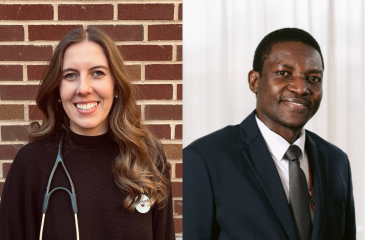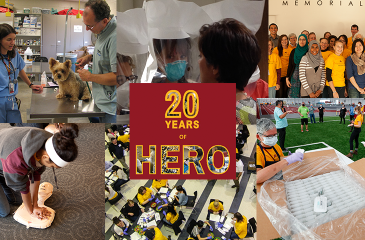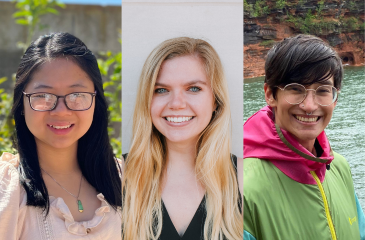M SIMULATION TRAINS HEALTH SCIENCES STUDENTS ON PPE
Over a hundred fourth-year medical students needed to return to the clinical environment by the end of June, so they turned to M Simulation for training on personal protective equipment (PPE). The M Simulation team includes 11 members working onsite since June 9 who have gone above and beyond to support learners during the pandemic. These team members include Ana Brakke, Dr. Lou Clark, Jon Chaika, Eugene Floersch, Joe Miller, Nick Newman, Zuzanna Pasek, Anna Preston, Dr. Zia Rasool, Anne Woll and Aaron Yeshe.
“Our mission is to provide high quality simulation education opportunities for them, and to do so in a way that reduces risk as much as possible for all involved including M Simulation team members. Safety is a guiding principle in simulation work under normal circumstances, and needs to be even more so now during COVID-19,” said Clark.

M Simulation Executive Director Dr. Lou Clark training three BSN students in PPE
The team is expected to train well over 1,500 medical and nursing students by the end of the summer. Because of COVID precautions, each staff member can train only three people at a time. In a four hour block, they can train up to 36 students. The M Simulation team completed their own PPE training at M Health Fairview just a week before implementing it for students. In June, M Simulation moved to the new Health Sciences Education Center. Within a week of relocating, they completed several simulation training sessions for medicine and surgery residents.
“Our human simulation operations were down for four days in March. We had to go figure out what to do and pivot quickly to bring our onsite standardized patient (SP) activities online. The team worked online from mid-March through mid-May and then we had to pivot again to move into our new HSEC facilities and begin residency bootcamps onsite in early June. The turnaround time was tight, and PPE training extends beyond our normal event schedule,” said Clark. “We're doing things simulation educators haven't done before, but our team is rising to the challenge. We are leading nationally and internationally in these efforts to bring human simulation online and expanding who we are, while moving ahead as safely as possible with our onsite work.”
From pivoting simulation learning online, launching a webinar series, developing flexible operations guidelines for educational partners, and now training students in PPE, M Simulation has been critical in the University of Minnesota’s COVID-19 response.
PREPARING HEALTH SCIENCES STUDENTS IN THE AGE OF COVID
A typical PPE training session goes like this: students are escorted into the building and screened for COVID-19 symptoms. They complete orientation, which includes watching a video that covers proper hand washing techniques and donning and doffing of PPE before practicing it themselves. Students cover their hands in Glo Germ, a gritty substance that simulates germs and can be seen under ultraviolet light. The material often gets caught around nail beds and cuticles, and students must wash their hands at separate stations, six feet apart, using the appropriate technique to remove all of the germs. They also learn how to clean their stethoscope and face shield correctly.
“Our objective by the end of the training is not only that learners understand the sequence of the moves, but also the rationale behind each move in terms of safety” said Clark. “It's little details like making sure that the glove is tucked into your gown because you don't want any part of the wrist exposed; making sure you put your gown ties in the back and not the front, because when you take them off, you don't want to be tempted to touch it because the material directly faces the patient and might be contaminated.”
Dr. Mark Rosenberg, vice dean for education for the Medical School, and Dr. Mojca Remskar, medical director for M Simulation, were instrumental in designing the curriculum for PPE training.
TRUE COLLABORATION AND LASTING PARTNERSHIP
After reaching out to M Simulation for PPE training over Zoom, Medical School colleagues on the Duluth campus have gone on to train 140 students. M Simulation will be continuing PPE training in the fall for a cohort of dietetic interns as well as new masters of nursing students.
“It's really been a ‘pay it forward’ kind of thing. We had six of us trained, and now we are training other trainers,” said Clark. “It's wonderful that leadership at the University of Minnesota has embraced this and us. I look forward to continuing collaboration and creating true partnership with our colleagues around the health sciences to expand what it is that we do as simulation educators.”
The M Simulation team is working at or above capacity to make all of this possible. They are passionate about supporting students and faculty and helping schools get learners back into clinical spaces. PPE training takes tremendous time and resources. As the team moves forward, they are keeping sustainability in mind. They are committed to improving their services and elevating the simulation profession.



